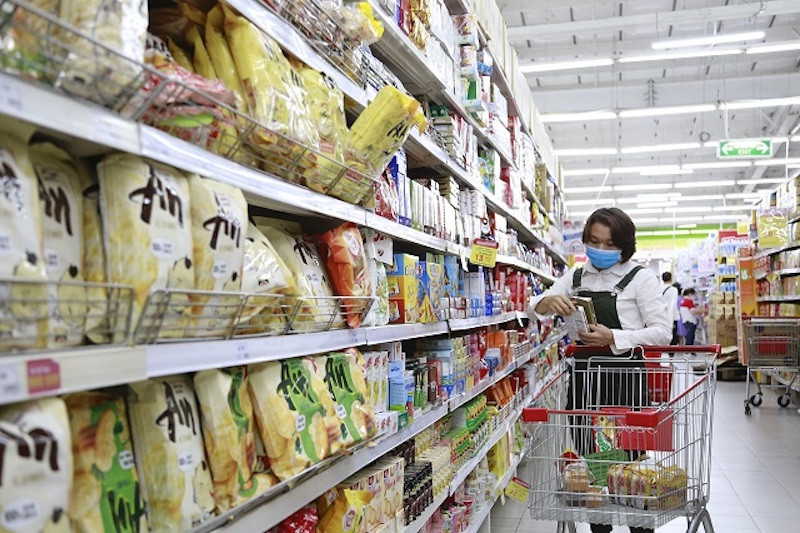Vietnam's retail property market will see robust growth in 2024 and the years to come, particularly in the food and beverage (F&B) sector and entertainment retailers such as cinemas and amusement parks, according to local experts.
 |
| Big C Thang Long supermarket. Photo: Thanh Hai/ The Hanoi Times |
Pham Ngoc Thien Thanh, Deputy Director of Research and Consulting at CBRE Vietnam, 2023 saw an influx and expansion of the F&B, entertainment, and fashion industries in the two major cities of Hanoi and Ho Chi Minh City.
She added that 2024 is predicted to be a busy year for the retail market, with five new projects opening in Hanoi, marking a total leasable area of nearly 40,000 square meters.
Similarly, in Ho Chi Minh City, two large shopping centers with a combined lettable area of almost 70,000 square meters will open. Existing shopping malls are performing relatively well, maintaining high occupancy rates.
Many foreign retail brands, especially premium and luxury brands, have reported good sales in Asia, including Vietnam. As a result, there is continued demand for store expansion.
In addition, quality retail space and prime locations remain scarce in Vietnam. Consequently, Vietnam's retail sales grew by 9.6% in 2023, lower than the 19.8% growth rate of the previous year. However, Thanh pointed out that this growth rate was still considered positive compared to many other regional countries.
Savills Vietnam believes that the retail property market in Vietnam in 2024 will be shaped by factors such as increased spending on services, a focus on sustainable and eco-friendly stores, and a focus on providing unique customer experiences. The combination of online and offline shopping through omnichannel retail strategies is also becoming popular, offering customers flexible and convenient shopping experiences.
Retailers are creating unique shopping spaces and new experiences, making retail a creative and attractive destination. This will undoubtedly increase the competitiveness of Vietnam's retail market in the future, as highlighted in the report.
On the other hand, there has been a significant increase in the number of reputable developers offering high-quality projects in suburban areas, providing local retailers with a wider range of options in terms of location and affordability.
This trend has led to new stores in non-central locations, such as Foot Locker, Karl Lagerfeld, and Dyptique at Lotte Mall West Lake Hanoi. Brands such as Muji and Uniqlo have expanded to many non-central areas after achieving success in previous locations, according to Savills Vietnam.
Savills Vietnam forecasts an additional four shopping centers and 11 retail podiums will enter the market between 2024 and 2026. Notable projects include Tien Bo Plaza, E-Mart, and The Linc @ ParkCity. This indicates that Hanoi's retail property market is experiencing strong development and promising opportunities for innovation.
Hanoi's commercial centers in the spotlight
Experts have said that shopping centers remain the most popular retail leasing option in Hanoi. However, these shopping centers need to be well-organized, from advertising strategies to tenant zoning and effective operational management. These are crucial factors for the operation and maintenance of shopping centers
Hoang Nguyet Minh, senior director of commercial leasing at Savills Hanoi, said the success of shopping centers depends on the effective combination of tenant zoning, including shopping, entertainment, and dining services
"Local customers are not only looking for shopping destinations but also for complete experiences with entertainment and dining. This can be seen in shopping centers such as Lotte Mall, which offers a variety of services, including supermarkets, cinemas, restaurants, and fashion stores on different floors," she said.
Lotte Mall West Lake Hanoi is the largest shopping center in Hanoi, comprising shopping centers, offices, serviced apartments and hotels, offering a unique experience with 233 shops, indoor amusement parks and an aquarium.
The appeal of this project is a typical example of how modern shopping malls attract shoppers through integrated entertainment, dining, and shopping experiences that cater to all age groups and customer segments.
Although shopping centers have many advantages, location also plays a vital role in the leasing decisions of brands in the Hanoi market, according to a Savills Vietnam expert.
For example, the Hoan Kiem area, as Hanoi's historical and cultural center, still attracts many civil servants, tourists, and residents. The area is home to government offices, embassies, and the headquarters of many multinational companies and retains its unique appeal, especially for premium brands.
In addition to existing brands, many other luxury brands worldwide are still interested in Hoan Kiem and are looking for suitable spaces according to their brand and business models, Minh said.
Trang Le, Head of Research and Consultancy Services at Jones Lang LaSalle Vietnam (JLL), said key commercial centers are expected to maintain their growth momentum thanks to stable tenant and customer traffic, which will continue to drive rental prices.
She added that developers will strive to maximize occupancy rates through rental pricing policies and closer cooperation with tenants.
Landlords will also continuously launch marketing activities to attract visitors to the shopping malls and regularly monitor the operations of the stores to make appropriate adjustments.
Savills Vietnam's forecast shows that the expected retail supply will increase by an additional 247,601 square meters by 2025. However, the challenge of limited supply in central areas of the city remains, with only 0.4% of future supply located in central areas.
"Retailers must, therefore, continue to seek innovative and flexible solutions in their choice of locations and business models," the report stated.
Source: Hanoitimes